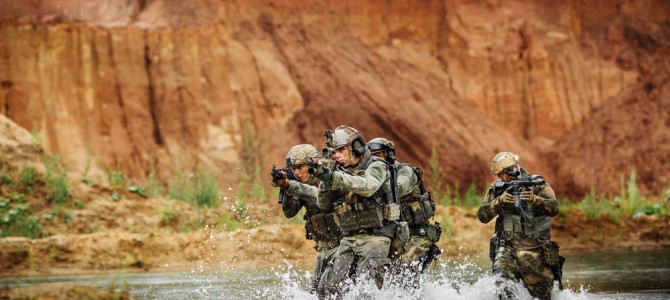
When Defense Secretary Ash Carter recently announced that he was opening all military positions to women, including frontline combat units and special operations teams, it was the culmination of a process whose conclusion was preordained.
Notably, the chairman of the Joint Chiefs of Staff, Marine General Joseph Dunford, was not standing alongside the secretary at that press conference. In his previous position as commandant of the Marine Corps, Dunford had overseen a study that showed that mixed-sex Marine combat units did not perform as well as all-male units. They were slower, suffered more musculoskeletal injuries, and could not shoot as well. They were, overall, less lethal than the all-male units. Based on that test, the Marine Corps had asked for an exception to the announced policy of opening all military positions to women.
But the corps should have known better. The way that policy had been announced back in 2013 by then-Chairman of the Joint Chiefs General Martin Dempsey, it was clear the fix was in. As Dempsey said, the onus was on those who objected to the policy.
While insisting that he would not lower standards in order to accept women into frontline units, Dempsey also said, “If we do decide that a particular standard is so high that a woman couldn’t make it, the burden is now on the service to come back and explain to the [Defense Secretary], ‘Why is it that high?’”
Past Performance No Guarantee of Future Results
Before proceeding further, let’s understand what this is not about. Yes, in counterinsurgency warfare, where the bad guys are everywhere, women have often found themselves in a firefight and have acquitted themselves well.
Women have also proved their worth in situations outside of combat. For example, the Army and Marines have used women in Cultural Support Teams and Female Engagement Teams, respectively, to interact with women and children in cultures where American men cannot. These women often garnered important information that led to the success of the mission and saved lives.
But that’s not what’s at issue here. It would be foolish to assume that all future conflicts will be like Iraq or Afghanistan. We must be prepared to fight across the full spectrum of warfare, from counterinsurgency or low-intensity conflicts to knock-down, drag-out clashes that rage across large battlefields with intense fighting that lasts days, weeks, or months. While all women in the military must be trained to fight and defend themselves, this new policy will open to women positions whose explicit purpose is to maneuver against and engage with enemy forces with speed and lethality.
This is not the same as being in a convoy that gets ambushed or arrives on the scene after the door-kickers have seized the target. It’s tough, nasty, dangerous business whose physical and mental demands tax even the healthiest and strongest of men. Merely getting shot at does not automatically qualify anyone for the combat arms.
In an article for the Marine Corps Gazette called “Get Over It! We Are Not All Created Equal,” Captain Katie Petronio described the physical toll she suffered while being involved in combat operations. She had been a standout athlete in college, able to bench press 145 pounds and squat 200 pounds. She was ranked fourth out of a class of 52 in Officer Candidate School and excelled at Marine Corps fitness tests. But while serving with an engineer unit, she lost 17 pounds on an already lean body and suffered a compressed spine that pinched on nerves.
“By the fifth month into the deployment, I had muscle atrophy in my thighs that was causing me to constantly trip and my legs to buckle with the slightest grade change. My agility during firefights and mobility on and off vehicles and perimeter walls was seriously hindering my response time and overall capability. It was evident that stress and muscular deterioration was affecting everyone regardless of gender; however, the rate of my deterioration was noticeably faster than that of male Marines and further compounded by gender-specific medical conditions.”
The Military Has Already Loosened Standards to Accommodate Women
This is not just anecdotal evidence. The aforementioned Marine Corps study, conducted by independent organizations under objective standards, clearly showed that women made a Marine combat unit less effective. The only possible outcome of this policy is more dead Marines.
Such stubborn facts do not dissuade those determined to remake reality, arguing, for example, that those who resist integrating women into the combat arms are the same as those 65 years ago who resisted integrating black soldiers into all-white units, as if prejudice based on an irrelevant characteristic such as skin color is the same as judgment based on objective, real-world capabilities.
Ellen Haring, who as an Army colonel, sued to open all positions to women, and wants to change the standards from physical stamina to a more nebulous one such as “coolness under fire,” citing examples such as the diminutive Audie Murphy in World War II and small-statured Vietnamese soldiers. She apparently fails to realize that all her examples are still male and that coolness under fire is meaningless if you are physically unable to fully engage in battle in the first place.
An even more preposterous idea comes from Elspeth Reeve. One of the arguments against women in combat units is the fact that they don’t have the upper-body strength to be able to carry a wounded buddy to safety. Reeve showed how a woman in carefully controlled conditions in a gym could hoist a large man onto her shoulders. The man wears nothing but a pair of shorts and helpfully leans over so the woman can lift him.
In reality, a wounded, unconscious Marine in full battle rattle could weigh as much as 250 pounds and will be deadweight on the ground, not helpfully hopping onto her shoulders.
This Means Breaking Faith with Troops
Another problem with the new policy is the poisonous effect it is already having on troop morale. Young soldiers, sailors, airmen, and Marines are not stupid. They hear their superiors mouthing words about maintaining standards and seeking input from all concerned, but then see the preordained results. Surveys were ignored and test results rejected. Notwithstanding assurances to the contrary, they see standards being changed.
Despite the carefully monitored trial conducted by the Marines, Navy Secretary Ray Mabus simply dismissed the results, saying that a few individual women could pass the physical tests and should be allowed to serve, ignoring the fact that Marines fight as members of a unit and that those mixed-sex units were not fully combat-capable.
Even though the Marine Corps had asked for a waiver to exempt women from combat units based on the results of its trial, Secretary Carter dismissed it with a wave of the hand. He didn’t even try to explain: “We are a joint force, and I’ve decided to make a decision that applies to the entire force.”
When two women recently passed the Army’s demanding Ranger Course, advocates hailed this as proof that women can meet the same standards as men. But almost immediately there came credible allegations that the women were given special treatment. The Army denies it, but it didn’t help its case when it was forced to concede that some of the women’s training records had been destroyed. The Army remains close-mouthed about its policy about women undergoing the Ranger Course, prompting the Army Times to publish an editorial calling for an end to the secrecy.
A Solution to a Nonexistent Problem
The change in policy is especially puzzling considering that it seeks to solve a problem that didn’t exist. The original movement to admit women to frontline combat units came from a small number of women who had selfish motives: their own careers.
It is difficult to get promoted to the higher ranks without have served at least one tour in a command position, and within the military those who have commanded a combat unit have a leg up on others who have not. The women argued that their career potential was constrained by the fact that they could not serve in, never mind command, a combat unit.
Otherwise, there was no clamor from women in uniform to gain admittance to the combat arms. Secretary Carter said part of his thinking was to broaden his recruitment pool: “To succeed in our mission of national defense, we cannot afford to cut ourselves off from half the country’s talents and skills,” he said.
But this policy is sure to backfire. A lot of women who might consider enlisting to serve in, say, computers or mechanics will now not enlist at all if they think there is any danger of being assigned to a combat unit. (At present, about 30 percent of combat units consist of men who did not volunteer for the position.) Will the new policy require personnel assignments to be divvied up evenly between men and women? Who knows?
This also impacts current law on conscription. All men must register with the Selective Service upon turning 18. (Student loans and other government benefits are denied to those who don’t register.) Will women now be required to register? In 1981 the Supreme Court ruled in Rostker v. Goldberg that the Selective Service could justify not registering women because its stated purpose was to raise “combat troops,” and because women at the time were banned from combat the exclusion did not violate equal protection laws. It seems that ruling is now moot. Army Secretary John McHugh sure seems to think so.
So to satisfy the career ambitions of a very small number of women and mollify the feminists who insist on “helping” women gain positions they wouldn’t dream of serving in themselves, every young woman age 18 to 34 is now at risk of being drafted and forced to serve in a combat unit, even if by doing so our nation puts its security at risk. The feminists and careerists will be happy, though.
A 1992 Presidential Commission on the Assignment of Women in the Armed Forces, the last extensive examination of gender integration within U.S. ground combat units, concluded in its formal report this way:
“A military unit at maximum combat effectiveness is a military unit least likely to suffer casualties. Winning in war is often only a matter of inches, and unnecessary distraction or any dilution of the combat effectiveness puts the mission and lives in jeopardy. Risking the lives of a military unit in combat to provide career opportunities or accommodate the personal desires or interests of an individual, or group of individuals, is more than bad military judgment. It is morally wrong.”









